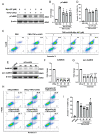MLKL and CaMKII Are Involved in RIPK3-Mediated Smooth Muscle Cell Necroptosis
- PMID: 34572045
- PMCID: PMC8471540
- DOI: 10.3390/cells10092397
MLKL and CaMKII Are Involved in RIPK3-Mediated Smooth Muscle Cell Necroptosis
Abstract
Receptor interacting protein kinase 3 (RIPK3)-mediated smooth muscle cell (SMC) necroptosis has been shown to contribute to the pathogenesis of abdominal aortic aneurysms (AAAs). However, the signaling steps downstream from RIPK3 during SMC necroptosis remain unknown. In this study, the roles of mixed lineage kinase domain-like pseudokinase (MLKL) and calcium/calmodulin-dependent protein kinase II (CaMKII) in SMC necroptosis were investigated. We found that both MLKL and CaMKII were phosphorylated in SMCs in a murine CaCl2-driven model of AAA and that Ripk3 deficiency reduced the phosphorylation of MLKL and CaMKII. In vitro, mouse aortic SMCs were treated with tumor necrosis factor α (TNFα) plus Z-VAD-FMK (zVAD) to induce necroptosis. Our data showed that both MLKL and CaMKII were phosphorylated after TNFα plus zVAD treatment in a time-dependent manner. SiRNA silencing of Mlkl-diminished cell death and administration of the CaMKII inhibitor myristoylated autocamtide-2-related inhibitory peptide (Myr-AIP) or siRNAs against Camk2d partially inhibited necroptosis. Moreover, knocking down Mlkl decreased CaMKII phosphorylation, but silencing Camk2d did not affect phosphorylation, oligomerization, or trafficking of MLKL. Together, our results indicate that both MLKL and CaMKII are involved in RIPK3-mediated SMC necroptosis, and that MLKL is likely upstream of CaMKII in this process.
Keywords: CaMKII; MLKL; abdominal aortic aneurysm; necroptosis; smooth muscle cells.
Conflict of interest statement
The authors declare no conflict of interest.
Figures





References
-
- Wang Q., Zhou T., Liu Z., Ren J., Phan N., Gupta K., Stewart D.M., Morgan S., Assa C., Kent K.C., et al. Inhibition of Receptor-Interacting Protein Kinase 1 with Necrostatin-1s ameliorates disease progression in elastase-induced mouse abdominal aortic aneurysm model. Sci. Rep. 2017;7:42159. doi: 10.1038/srep42159. - DOI - PMC - PubMed
-
- Zhou T., Wang Q., Phan N., Ren J., Yang H., Feldman C.C., Feltenberger J.B., Ye Z., Wildman S.A., Tang W., et al. Identification of a novel class of RIP1/RIP3 dual inhibitors that impede cell death and inflammation in mouse abdominal aortic aneurysm models. Cell Death Dis. 2019;10:226. doi: 10.1038/s41419-019-1468-6. - DOI - PMC - PubMed
Publication types
MeSH terms
Substances
Grants and funding
LinkOut - more resources
Full Text Sources
Miscellaneous

